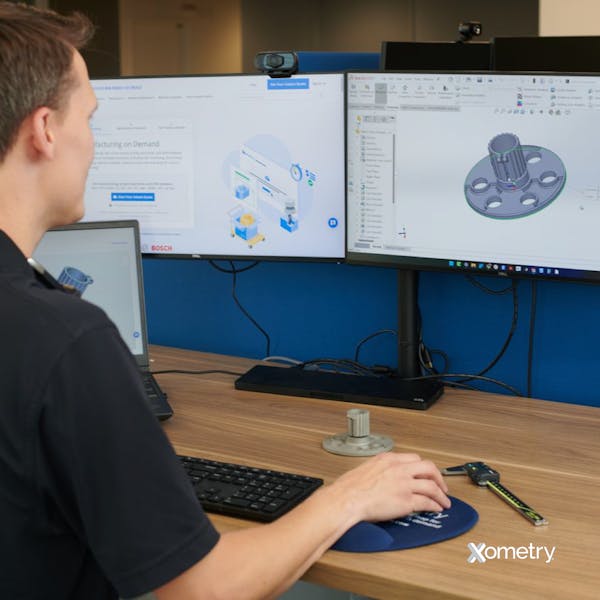Solid Edge and Solidworks are both computer-aided design (CAD) software tools used for 3D design, manufacturing, and simulation. The former is developed by Siemens, and the latter by Dassault Systèmes. They are very similar tools, but they do have a few different features and capabilities. Let’s look at these in more detail, including their common applications, system requirements, and user experience.
What is Solid Edge?
Used mainly in the engineering industry, Solid Edge has many useful 3D design features like assembly design, solid modeling, and 2D drafting. It also has user-friendly tools for simulation and manufacturing like finite element analysis (FEA), computational fluid dynamics (CFD), computer-aided manufacturing (CAM), and tooling design.
What is Solidworks?
Solidworks is a CAD software program used to create and edit designs and drawings of 3D models and it’s crammed with tools for simulation, rendering, and product data management. Users can put in their dimensions and constraints and then modify them. It’s a hit with Xometry customers, including professional engineers and designers. This program is used quite a bit in aerospace, automotive, and manufacturing. The below image shows Solidworks in action.

Designing in Solidworks
Solid Edge vs. Solidworks - Use Cases and Applications
Both Solid Edge and Solidworks are powerful and feature-rich CAD tools that can be used in a range of industries and applications. They both support product design in the manufacturing, automotive, and aerospace industries. Solid Edge and Solidworks include a range of tools for creating and editing 3D models, as well as tools for simulating and testing designs
The main difference between the two is the focus of their features and tools: Solid Edge is geared more towards engineering and manufacturing, while SolidWorks is more focused on product design.
Solid Edge vs. Solidworks - System Requirements
You’ll find the system requirements for each program in the table below.
| Requirements | Solid Edge | Solidworks |
|---|---|---|
Requirements Processor | Solid Edge Intel Pentium 4 or equivalent | Solidworks Intel Pentium 4 or equivalent |
Requirements Operating System | Solid Edge Windows 10, 11 (professional or enterprise), 64-bit version only 1909 and above | Solidworks Windows 10 or Windows 11 (64-bit for both). It can also run on macOS, but you’ll need to install it via a third-party app. |
Requirements Memory | Solid Edge 8 GB RAM for users in academia and 16 GB for commercial use | Solidworks 32 GB or 64 GB RAM |
Requirements Hard Disk Space | Solid Edge A minimum of 7.5 GB | Solidworks 20 GB |
Requirements Screen Resolution | Solid Edge 1920 x 1080 | Solidworks 1920 x 1080 |
System Requirements
What Operating Systems Do Solid Edge and Solidworks Support?
Both Solid Edge and Solidworks run only on the Windows operating system. They are compatible with the 64-bit versions of Windows 10 and 11. Solidworks can run on macOS but needs a third-party application to install.
What Are the Minimum Memory Requirements for Solid Edge and Solidworks?
Like all software programs, Solid Edge and Solidworks require a certain minimum amount of RAM to run smoothly. But the exact amount of memory required can vary depending on the specific needs of the user and the complexity of the designs being created. The minimum memory requirement for Solid Edge 2022 is 8 GB RAM for users in the academic field and 16 GB for commercial users. The minimum memory requirement for SolidWorks is 32 GB or 64 GB RAM. It's important to note that these are just the minimum memory requirements and that more memory may be required for larger or more complex designs. Additionally, having more memory can generally lead to improved performance and a smoother user experience.
What File Formats Do Solid Edge and Solidworks Support?
We’ve listed each program’s supported file formats in the below table.
| Solid Edge | SolidWorks |
|---|---|
Solid Edge dft (drafting file) | SolidWorks sldprt (Solidworks part file) |
Solid Edge par (part file) | SolidWorks sldasm (Solidworks assembly file) |
Solid Edge asm (assembly file) | SolidWorks slddrw (Solidworks drawing file) |
Solid Edge psm (presentation file) | SolidWorks pdf (Adobe portable document) |
Solid Edge dwg (AutoCAD drawing file) | SolidWorks dwg (AutoCAD drawing file) |
Solid Edge stl (Stereolithography file) | SolidWorks stl (Stereolithography file) |
Supported File Formats
Solid Edge vs. Solidworks - User Experience
Given the large variety of Xometry customers, each of these two software programs may appeal to different users because of what they’re like to use — with the main difference between them being the user interface. Solid Edge is more modern and streamlined, whereas Solidworks looks and feels more traditional, similar to other CAD programs. Solidworks is also more complicated because it offers lots of features, so if you’re new to CAD, try Solid Edge first which has less of a learning curve.
Both programs are considered stable, so if you’re worried about whether they’ll be reliable or not in the long run, don’t be. They are both continually developed and updated and have file recovery tools that can help keep your work backed up and safe in the event of a crash.
Learning Curve of Solid Edge and Solidworks
The term “learning curve” refers to the amount of time and effort it takes for a user to become proficient with a software program. SolidWorks is known for being a very feature-rich and powerful program, with a wide range of tools and options that can be overwhelming for some users. As a result, the learning curve for SolidWorks may be steeper for users who are new to CAD or who are not familiar with similar software.
Solid Edge, on the other hand, is designed to be more user-friendly, with a focus on making it easier for users to get up and running quickly. This means that the learning curve for Solid Edge may be easier, particularly for users who are new to CAD. However, Solid Edge still has a lot of advanced features and capabilities to serve the needs of users who need the full functionality of a professional-level CAD program. Both programs offer a wide range of tutorials, documentation, and other resources to help users learn the software, so it is generally possible for users to become proficient with either program with some time and effort.
Is Solid Edge Easier To Learn and Use Than Solidworks?
Solid Edge is easier to learn and use than Solidworks. Solid Edge is known for its user-friendly interface and intuitive workflow. It is generally considered to be easier to learn than other professional-grade 3D modeling software because it provides a variety of tools and resources to help users get up to speed quickly.
SolidWorks, on the other hand, is a more advanced 3D modeling software that is used by many professional designers and engineers. It offers a variety of advanced tools and features for designing, simulating, and manufacturing products, but it may be more complex to learn and use than Solid Edge for users who are new to 3D modeling software.
Solid Edge vs. Solidworks - Application Stability
Solid Edge and Solidworks are both extensively used and have continued to be developed and updated over the years. Both programs have a reputation for being stable and reliable. Both programs have performance optimization tools that can help reduce lag and latency. They also have file recovery tools that can help recover unsaved work in the event of a crash.
Solid Edge vs. Solidworks - Customer Support
Regardless of which program you go for, you won’t be left helpless. They both offer good support and resources like online tutorials, webinars, and user forums. Additionally, they both offer email support, on-site training, and consultation, although Solidworks offers these through certified partners.
Solid Edge vs. Solidworks - Community
Both Solid Edge and Solidworks have their own online communities where you can ask any questions or share suggestions at any time. There’s no shortage of information there so you’ll be covered for almost anything you might need help with. In terms of community size, Solidworks probably has a larger community because it’s the most used of the two programs.
Solid Edge vs. Solidworks - Price
For some people, it all comes down to this: Solid Edge is cheaper. It’s not entirely in black and white, though. Solidworks offers different pricing options, including a subscription and a perpetual license option. For specific prices, you’ll have to visit the company’s website for a quote. On the other hand, Solid Edge offers a subscription model that starts at around $83 per month for the basic 3D CAD package. Prices can vary depending on factors like whether or not you can obtain a discount or promotion code and which package you opt for.
Alternatives to Solid Edge and Solidworks
If neither of these two programs is to your liking, you could opt for an alternative like AutoCAD, which is great for creating 2D and 3D designs, Autodesk Fusion, which is good for product design and manufacturing, or Inventor, which is popular among Xometry customers for mechanical design and engineering. All of these programs are pretty much on par with Solid Edge and Solidworks when it comes to popularity and professionalism, and for macOS users, you’ll be glad to know that AutoCAD and Fusion are both available on Mac and mobile devices in addition to Windows.
How Xometry Can Help
Xometry offers a wide range of manufacturing capabilities and support. With a focus on on-demand precise manufacturing, Xometry offers a range of services including CAD add-ins, design, CNC machining, milling, turning, 3D printing, injection molding, and sheet metal fabrication. If you need further advice or want to learn more about CAD software, a Xometry representative is always ready to help.
Copyright and Trademark Notices
- SolidWorks® is a registered trademark of Dassault Systèmes SolidWorks Corp.
- Solid Edge® is a registered trademark of Siemens Industry Software.
- AutoCAD®, Autodesk®, Fusion®, and Inventor® are trademarks of Autodesk, Inc., and/or its subsidiaries and/or affiliates, in the United States.
Disclaimer
The content appearing on this webpage is for informational purposes only. Xometry makes no representation or warranty of any kind, be it expressed or implied, as to the accuracy, completeness, or validity of the information. Any performance parameters, geometric tolerances, specific design features, quality and types of materials, or processes should not be inferred to represent what will be delivered by third-party suppliers or manufacturers through Xometry’s network. Buyers seeking quotes for parts are responsible for defining the specific requirements for those parts. Please refer to our terms and conditions for more information.


